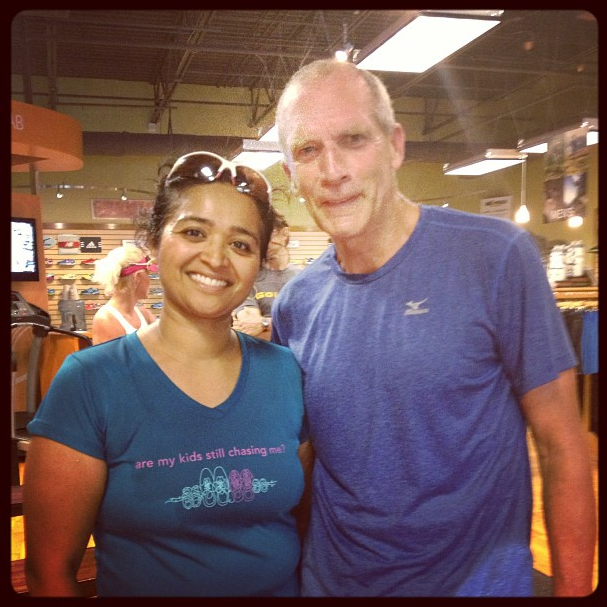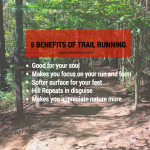Yesterday, I had the chance to run and then hangout with Bart Yasso at Big Peach Running Company, our local running store. Both run and hangout are very loose terms that I will deliberately not elaborate on 🙂
(As hard as it may be to believe, I did not stalk him but instead learnt of his run at the store through twitter #runchat)
After a short easy 3.5 mile run, Bart took the time to talk to us about running and a few snippets out of his book “My Life on the Run” (a great read, btw).

(Side note: I have a BAD case of muffin top! Ugh!!)
Here are some takeaways from his advice to the crowd yesterday.
The importance of running slow
- Recovery runs are essential.
- Running slow and easy on recovery days makes for faster and injury free runners.
- Kenyans who run 2:04 marathons run their easy runs at 8:30 pace. This makes them ready to go and hit it all when they do their fast workouts.
- Long slow runs should be run long and slow.
- Aim to pace the long run so you end with negative splits, with the first 30% of the run really slow. This strategy also helps in a race when running strong around other people towards the end sends you positive energy.
Cross-training, Flexibility and a Strong Core helps keep the runner injury free.
- Usually runners take to cross training when they are injured. Cross training before getting injured prevents injury.
- Elliptical and pool running was his preferred form of cross-training – both are low impact and simulates the running action. Swimming and cycling are other low impact cross-training.
- It is not needed to be master yogi flexible, but some amount of flexibility and core strength helps maintain posture during the later stages of a race. It prevents the runner from hunching over and hence, reducing oxygen supply which in turns negatively affects performance.
Running Form
- There is a reason why every individual runs the way they do. So a little tweaking is all we can do to make it better.
- But over striding causes problems, so concentrate on not over striding and increasing stride count.
- Stride count (cadence) can be increased by training on the track and consciously making an effort to increase it (principles similar to CHI running).
On Marathon Training
- Start with a plan of 16 weeks with a comfortable base of 35-40 miles/week with maximum 4-5 days/week of running.
- Main quality runs are –
- intervals/hill repeats (teaches fast leg turnover),
- long run at slower than race pace (builds endurance),
- tempo runs from 6 miles going up to 12 miles at race pace (simulates the race).
- The rest should be easy recovery runs of around 5 miles.
- Avoid junk miles or 3 miles or so (!!).
- Taper is an important park of marathon training. He recommended 3 weeks of the traditional taper going from 80 miles of max running to 30 miles (other than race miles) on race week. (I was surprised at how many people in the crowd groaned at the 3 weeks of taper. I always took it as gospel and understood the theory behind it.)
- While the miles during taper are reduced, it is important not to give up on the speed workouts. Keep with all the workout components, just at a reduced %. Keeping with workouts and not completely cutting down also helps, to some extent, to keep the sickness at bay. (Since I have had the exact same issue of falling sick in taper, it was heartening to hear that I was ‘normal’ and that there might actually be a workaround it)
(The marathon training is the one piece of advice that is hardest for me to swallow. I cannot imagine 60-80 miles of peak week running. At my pace, I would be running all day! Does it mean that I cannot reach my potential? Maybe. Does it mean that I cannot train for a marathon? No! The next time I run a marathon, I am hoping to have increased my base to running 5 days/week compared to the 3-4 that I’ve done until now.)
On Half Marathon Training
- Reduce most of the marathon training time/distance to half; giving it 15-20hrs of base running with 35-40 hours of peak running at 4-5/week of running.
- Speed workout he recommended instead of the Yasso800s of marathon training was 20x400s w/200 recovery. (The entire room gasped at the thought of 20 of those!!)
Strength Training
- Strength training is important for runners.
- Bootcamp, circuit training, crossfit, etc., as long as it is done during the off season.
- When training for a marathon specifically, concentrate on the miles and cross training.
(I especially liked how he did not diss any form of strength, rather pointed out that they all have their proper time and place)
Runners who are Triathletes
- Pick one season for each.
- Back off on running in the triathlon season and increase the biking.
- Keep up with swimming as cross-training in both seasons.
( As I personally am struggling to fit it all in with running and trying to tri, this made total sense and it takes the stress out too. I just wish that I was a little better planned with my goals to do it. But this year is all about exploring options, so I will skip this piece of advice for now 😉 )
Thank you, Big Peach Running and Mizuno for giving us this opportunity to hangout with Bart Yasso. For my friends who know of thrill in stalking meeting him last year, here’s my notes from talking to him last year.
What is the biggest piece of advice that surprised you and that you wish you had known before? What reinforces running knowledge/theory that you’ve always known? What are the things that you do completely contrary (like some people with taper) and how does that work for you?






